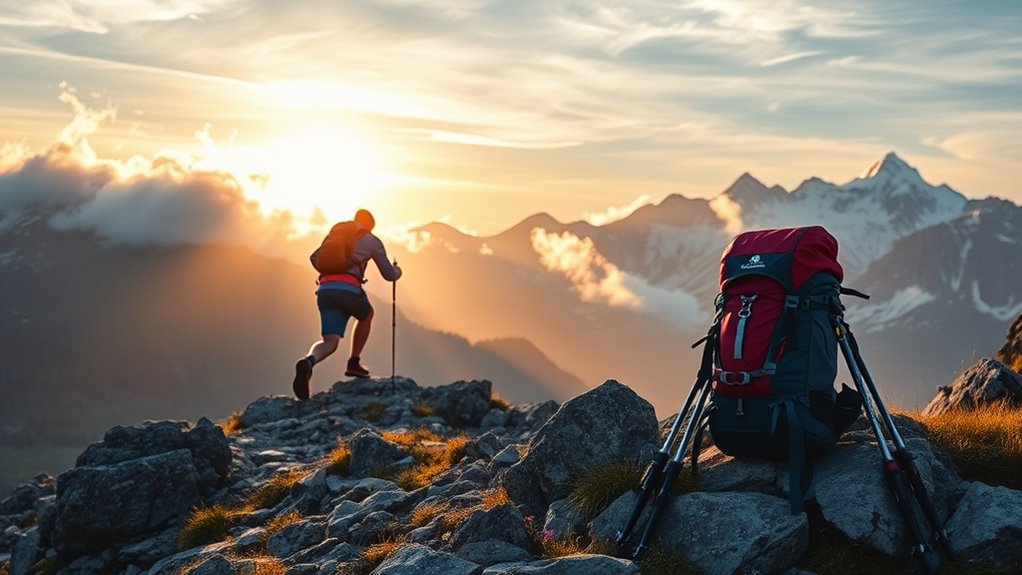To train for high-altitude trekking while traveling, assess your fitness level with endurance, strength, and flexibility exercises. Incorporate cardio workouts using local trails and perform bodyweight strength routines anywhere. Focus on flexibility and mobility through yoga and dynamic stretches. Stay hydrated and choose nutritious foods for energy. Schedule rest days to recover, and practice controlled breathing techniques to enhance stamina. With a solid plan, you’ll be ready to conquer those peaks and discover even more strategies for success.
Nomad Highlights
- Assess your current fitness level with endurance, strength, and flexibility exercises, using local trails for practical evaluation while traveling.
- Incorporate bodyweight exercises like push-ups and squats into your routine, ensuring strength training is accessible anywhere.
- Schedule rest and recovery days, including gentle stretching or yoga, to allow your body to adapt and rebuild during travel.
- Focus on hydration by drinking at least 3 liters of water daily, supplemented with electrolytes, especially at high altitudes.
- Practice diaphragmatic breathing techniques to enhance oxygen delivery, reduce anxiety, and improve endurance during trekking adventures.
Assess Your Current Fitness Level
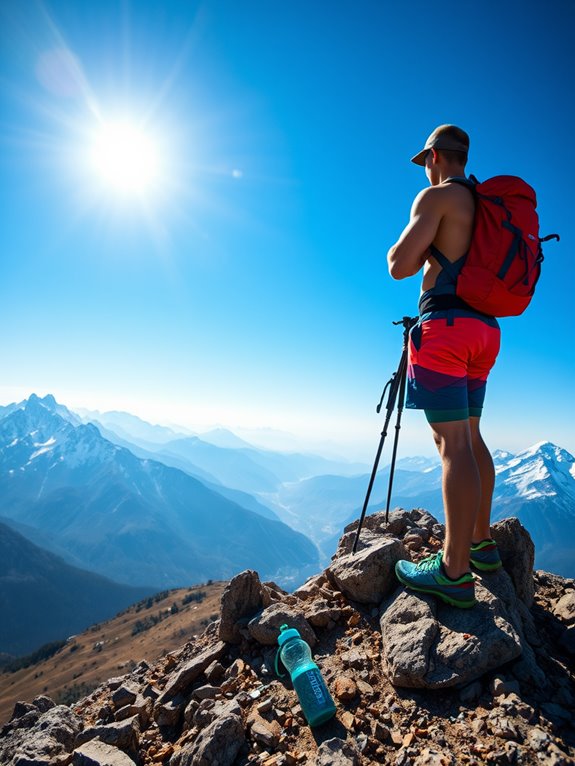
Before you commence your high-altitude trekking adventure, it’s essential to assess your current fitness level to guarantee you’re prepared for the challenges ahead.
Start with a fitness assessment that evaluates your endurance, strength, and flexibility. You’ll want to engage in activities like brisk walking, jogging, and hiking to gauge how your body reacts to elevation changes. Incorporating resistance bands into your routine can enhance your strength training and flexibility, which are crucial for tackling steep trails. These bands offer versatile tools for various exercises that can significantly improve your overall fitness. Additionally, utilizing multiple resistance levels can help you progressively build strength tailored to your fitness needs. Regular cardiovascular exercises will not only improve your endurance but also enhance your blood circulation, which is vital for high-altitude performance.
Pay attention to your cardiovascular health—how quickly you recover after exertion matters. Consider tracking your performance over a few weeks, noting improvements and areas needing work.
Incorporating exercises using exercise sliders can enhance your core strength and flexibility, which are crucial for tackling steep trails. This insight will enhance your trekking readiness, ensuring you can tackle steep trails without feeling overwhelmed.
Incorporate Cardio Workouts Into Your Travel Routine
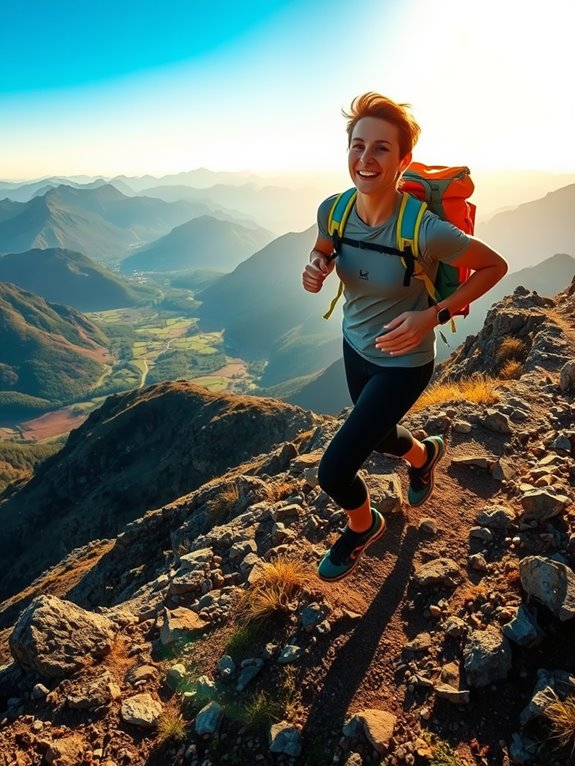
When you’re traveling, don’t let your fitness routine take a backseat; instead, embrace the beauty around you. Utilize local trails for an invigorating cardio workout that not only boosts your stamina but also lets you soak in stunning landscapes. If you’re at a hotel, make the most of the gym facilities to keep your heart rate up and prepare your body for the challenges of high-altitude trekking. Additionally, consider incorporating breath training devices into your routine to enhance your lung capacity and overall respiratory efficiency. Engaging in sport-specific exercises during your travels can also help you maintain a high level of fitness tailored to your trekking goals. To further enhance your workouts, consider using smart jump ropes for tracking your performance and staying motivated while on the go. Incorporating adjustable resistance settings in your travel workouts can also help simulate the varied terrain you will encounter during your trekking adventures, similar to how resistance bands can effectively target various muscle groups for strength training.
Utilize Local Trails
As you prepare for high-altitude trekking, utilizing local trails can seamlessly integrate cardio workouts into your travel routine.
Explore nearby parks or nature reserves to discover local trail options that challenge your endurance and build strength. Whether you’re hiking steep inclines or meandering through flat paths, each step elevates your fitness and acclimatizes your body to altitude changes. Incorporating energy-efficient designs can help you maintain peak performance during your travels as you work on your fitness goals. Additionally, consider bringing along a compact foam roller to relieve muscle tension after your hikes, enhancing your recovery process. Using adjustable footrests can also improve your posture and comfort during long travel hours, making it easier to stay active. Don’t forget that incorporating detailed sleep analysis can further support your recovery and performance during high-altitude treks. Water-filled dumbbells can serve as an excellent portable strength training solution to complement your cardio workouts while traveling, providing adjustable weights for varied resistance.
Before you head out, remember trail safety tips: always inform someone of your route, carry water, and wear appropriate gear.
Embrace the local scenery as you power through your cardio sessions, transforming ordinary travel into an extraordinary adventure.
Hotel Gym Workouts
Hotel gyms can be a hidden gem for travelers looking to maintain their fitness routine while on the go.
With a bit of creativity, you can easily incorporate cardio workouts into your daily schedule, even with limited hotel equipment.
Here are some innovative gym routines you can try:
- Treadmill intervals: Alternate between sprinting and walking for an effective cardio boost.
- Stationary bike sprints: Pedal at high intensity, then recover with a steady pace.
- Bodyweight circuits: Mix push-ups, squats, and burpees for a full-body workout.
- Jump rope: A portable option that elevates your heart rate quickly.
- Yoga/stretching sessions: Improve flexibility and recovery after a long day of exploring. Incorporating suspension training kits can also enhance your workout routine, providing diverse exercise options. Additionally, using adjustable dumbbells can add strength training to your routine, maximizing your workout versatility.
Incorporating portable kettlebells can further diversify your workouts, allowing you to effectively build strength and endurance while traveling. Exercise sliders can also be a great addition to your hotel gym routine, offering versatile exercise applications to keep your workouts engaging.
Incorporating ergonomic designs can enhance your comfort during workouts, making it easier to maintain your routine.
Stay committed, and you’ll be ready for those high-altitude treks!
Utilize Bodyweight Exercises for Strength Training
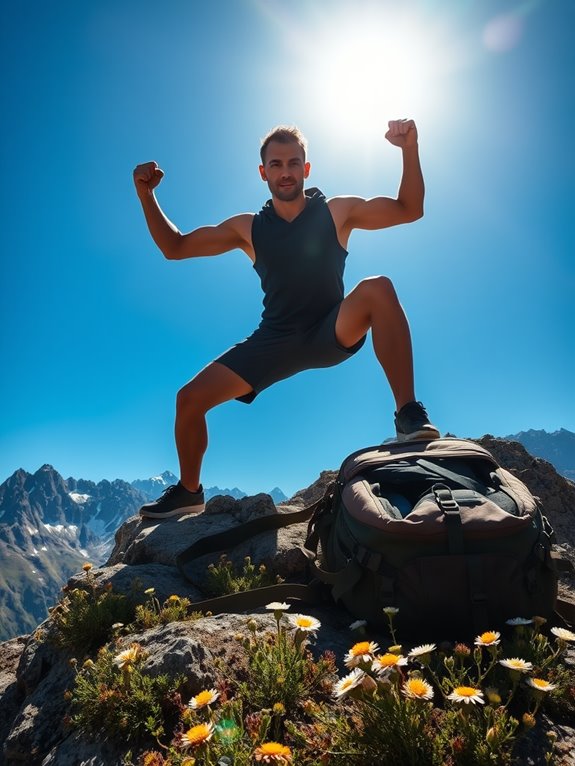
While preparing for high-altitude trekking, incorporating bodyweight exercises into your strength training routine can be a game-changer for your endurance and stability.
These exercises, like push-ups, squats, and lunges, require no equipment and can be performed anywhere, making them perfect for a traveling lifestyle. Exercise dice can also add an element of fun and unpredictability to your workouts, keeping you engaged during your training. Engaging in stress-relief activities such as coloring can also complement your physical training by promoting relaxation and mental focus. Additionally, integrating mini steppers into your routine can enhance your cardiovascular health and lower limb strength, essential for trekking. To further support your training, consider exploring a variety of unique products designed for outdoor enthusiasts that can enhance your trekking experience.
By creating bodyweight circuits, you can elevate your heart rate and build strength simultaneously. Aim for progressive overload by increasing reps or adding variations, like single-leg squats or decline push-ups, to enhance your strength progression.
Incorporate bodyweight circuits to boost endurance and strength, focusing on progressive overload with varied exercises.
This method not only improves your muscular endurance but also helps build the core stability essential for tackling rugged terrains. Additionally, integrating resistance training can significantly boost your overall performance and endurance during treks.
Embrace these dynamic exercises, and you’ll find yourself better prepared for the challenges of high-altitude trekking.
Focus on Flexibility and Mobility
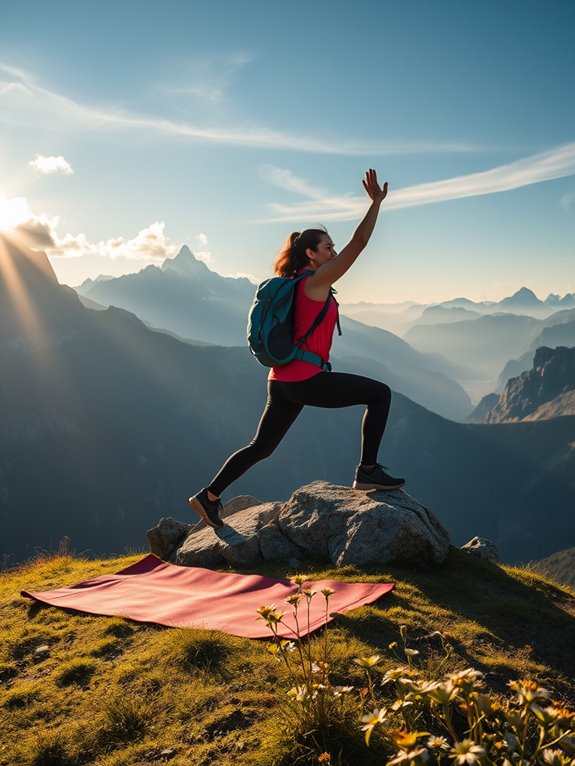
Building strength with bodyweight exercises sets a solid foundation, but don’t overlook the importance of flexibility and mobility in your training regimen. Incorporating dynamic stretching and yoga poses will enhance your performance and help prevent injuries during high-altitude trekking.
Here are some effective strategies to boost your flexibility and mobility:
- Dynamic stretching: Warm up with movements that mimic trekking motions to increase blood flow.
- Yoga poses: Integrate poses like Downward Dog and Warrior to improve overall body flexibility. Ergonomic designs can also enhance your overall comfort during training sessions.
- Hip openers: Focus on stretches targeting your hip flexors for better stride length.
- Foam rolling: Use this technique to relieve muscle tension and improve recovery, as it effectively mimics professional massage techniques for enhanced relief. Additionally, using high-density foam rollers can provide a deeper massage experience, further aiding in muscle recovery. Maintaining proper posture during these exercises can also enhance your flexibility gains.
- Consistent practice: Aim for a few sessions weekly to maintain and enhance your mobility.
Incorporating unique products designed for flexibility training can further enhance your routine. Embrace these elements for a well-rounded training approach!
Make Use of Your Environment for Training
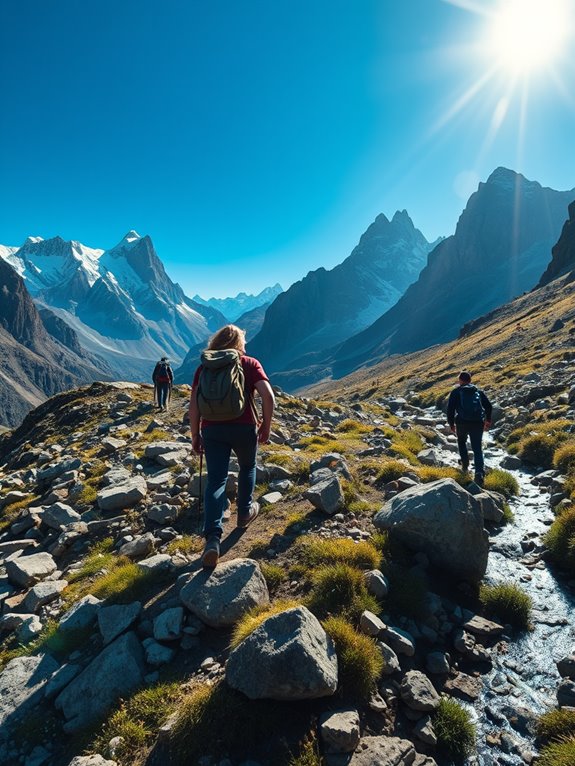
Nature offers a rich playground for your training, transforming everyday environments into powerful workout spaces. Embrace the hills and valleys around you; these natural obstacles can enhance your strength and endurance. The compact nature of travel spice kits can inspire you to think creatively about packing for your adventures.
Use stairs, curbs, and rocky paths to create dynamic workouts that mimic high-altitude conditions. As you climb hills, your body will develop crucial environmental adaptations, prepping you for the challenges ahead. Consider incorporating a travel-sized yoga mat to facilitate stretching sessions that enhance flexibility and recovery. Additionally, engaging in outdoor activities can help you discover unique products that cater to your fitness needs while on the go.
Incorporate bodyweight exercises like squats and lunges on uneven terrain, improving your balance and core stability. Travel-sized archery sets offer a fun way to engage in outdoor recreation while honing your focus and concentration. Explore trails where you can sprint or hike, allowing varied intensity in your routine. Additionally, consider using lightweight travel yoga mats for quick stretching sessions to enhance flexibility and recovery.
Stay Hydrated and Maintain Proper Nutrition
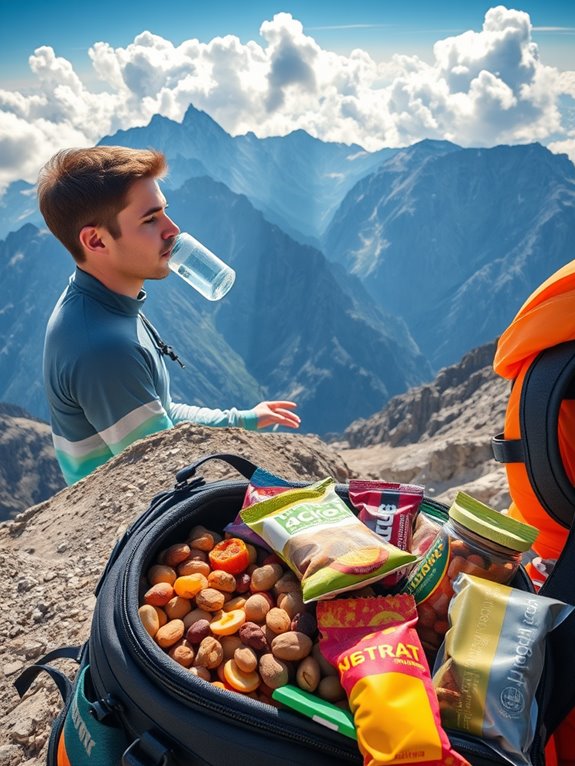
Training in diverse environments can elevate your fitness, but to truly prepare for high-altitude trekking, it’s crucial to focus on hydration and nutrition. Maintaining ideal hydration strategies guarantees your body performs at its best, especially in thin air.
Preparing for high-altitude trekking requires a strong emphasis on hydration and nutrition for optimal performance.
Pair this with the right nutrition sources to fuel your adventures.
- Drink at least 3 liters of water daily, adjusting for activity level.
- Incorporate electrolyte-rich beverages to combat altitude sickness.
- Choose complex carbohydrates for sustained energy.
- Include lean proteins to support muscle recovery.
- Snack on nutrient-dense foods like nuts and dried fruits.
With these approaches, you’ll bolster your endurance and resilience, paving the way for a successful high-altitude experience.
Schedule Rest and Recovery Days

As you push your limits during high-altitude training, don’t underestimate the importance of scheduling rest and recovery days. These days are crucial for allowing your body to adapt and rebuild, enhancing your performance.
Incorporate innovative rest strategies like yoga or gentle stretching to promote flexibility and circulation. Consider using recovery techniques such as foam rolling or ice baths, which can greatly reduce muscle soreness and inflammation.
Prioritize sleep, aiming for at least seven to eight hours to optimize recovery. Listen to your body; if you feel fatigued, don’t hesitate to take an extra day off.
Practice Breathing Techniques for Altitude Adjustment

To thrive at high altitudes, mastering your breathing can make all the difference.
You’ll want to incorporate diaphragmatic breathing exercises and controlled techniques into your training routine.
These methods not only enhance oxygen intake but also help your body adapt to the thinner air, keeping you energized on the trails.
Diaphragmatic Breathing Exercises
Mastering diaphragmatic breathing exercises can greatly enhance your ability to adjust to high altitudes. This technique optimizes oxygen intake and helps you combat altitude sickness.
By focusing on your diaphragm, you can experience the following diaphragmatic benefits:
- Increased lung capacity
- Enhanced oxygen delivery to muscles
- Reduced anxiety and stress levels
- Improved stamina and endurance
- Better overall respiratory function
To practice, find a comfortable position, place one hand on your chest and the other on your abdomen, and inhale deeply through your nose, expanding your diaphragm. Exhale slowly through your mouth.
Incorporating these breathing techniques into your daily routine can greatly prepare you for the challenges of high-altitude trekking, allowing for a smoother and more enjoyable experience.
Controlled Breathing Techniques
Building on the foundation of diaphragmatic breathing, controlled breathing techniques can further enhance your performance at high altitudes. By consciously adjusting your breathing patterns, you improve your body’s oxygen intake and promote altitude acclimatization.
Start with a four-square breathing method: inhale for four counts, hold for four, exhale for four, and pause for another four. This rhythmic approach calms your nervous system, helping you manage stress and fatigue.
Practice this technique during your travels, especially in high-altitude environments, to condition your body. As you refine these controlled methods, you’ll notice increased endurance and mental clarity, making your trekking experience not just bearable but exhilarating.
Embrace these techniques, and elevate your high-altitude adventures!
Set Realistic Goals for Your Trekking Adventure
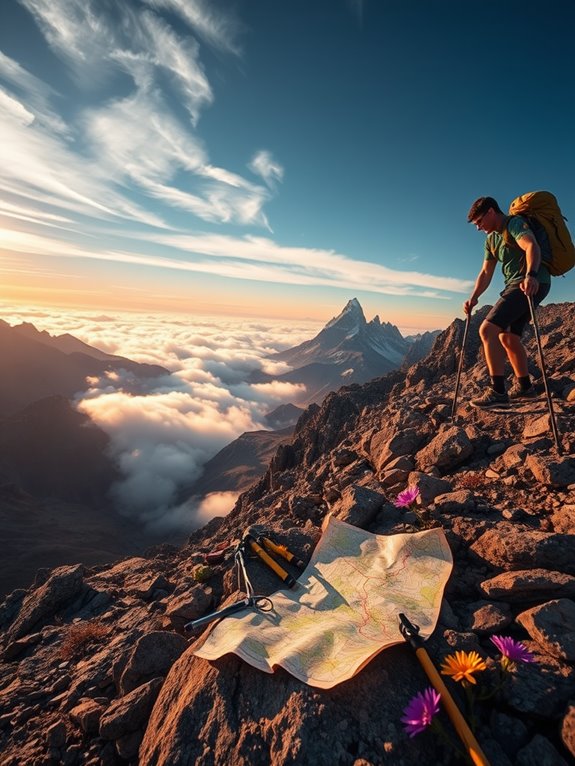
As you gear up for a high-altitude trekking adventure, setting realistic goals is essential for ensuring both safety and enjoyment. Proper goal setting helps you develop realistic expectations, enabling a successful expedition.
Here are five tips to guide your planning:
- Assess your fitness level: Understand your current endurance and tailor your goals accordingly.
- Factor in altitude: Allow extra time to acclimatize to high elevations.
- Plan for rest days: Include downtime to rejuvenate and recover.
- Set daily distance targets: Break your journey into manageable segments.
- Be flexible: Adapt your goals based on weather conditions and physical responses.
Frequently Asked Questions
What Gear Is Essential for High-Altitude Trekking?
When you’re gearing up for high-altitude trekking, certain essentials can make all the difference.
Start with moisture-wicking base layers and insulating mid-layers for temperature regulation. A waterproof and breathable outer layer is essential.
Don’t forget sturdy hiking boots with good ankle support. Accessories like a warm hat, gloves, and UV-protective sunglasses are also important.
Invest in quality gear recommendations to guarantee safety and comfort on your adventure, keeping you focused on the breathtaking view ahead.
How Do I Prevent Altitude Sickness While Training?
To prevent altitude sickness while training, focus on effective hydration strategies and proper breathing techniques.
Drink plenty of water to keep your body hydrated, as dehydration can worsen symptoms. Incorporate deep breathing exercises to enhance oxygen intake and help your body acclimate.
Gradually increase your elevation during training, allowing your body to adjust. Listen to your body, and if you feel unwell, descend to lower altitudes and rest.
Can I Train for Altitude Trekking Without a Gym?
Training for altitude trekking without a gym is like sculpting a masterpiece from raw marble—your body can become a work of art through determination and creativity.
Embrace bodyweight exercises like push-ups and squats, and take to the great outdoors for hiking, running, or biking.
These outdoor activities not only build strength and endurance but also acclimate your body to varied terrains.
What Should I Eat Before and After Hikes?
Before your hike, pack nutritious pre-hike snacks like energy bars, trail mix, or fresh fruit to fuel your journey.
These quick bites provide essential carbohydrates for energy.
After your trek, focus on post-hike recovery with protein-rich foods like yogurt or a protein shake, paired with complex carbs like quinoa or sweet potatoes to help your muscles recover.
Staying hydrated is vital, so keep water or electrolyte drinks handy to replenish lost fluids.
How Long Should I Train Before My Trek?
You’ve gotta train like a mountain goat preparing for a marathon!
Ideally, you should aim for at least 8 to 12 weeks of dedicated training before your trek. This training duration allows you to build endurance, strength, and stamina—key elements for successful trek preparation.
Incorporate long hikes, strength workouts, and cardio sessions into your routine.
You’ll conquer those peaks with confidence, feeling as unstoppable as a superhero in the wild!
Conclusion
So, gear up and get ready to conquer those towering peaks like a mountain goat on espresso! With a little dedication and creativity, you can transform any travel spot into your personal training ground. Picture yourself scaling heights you once thought impossible, breathing in crisp mountain air while your friends marvel at your newfound prowess. Remember, every step you take now is a leap toward adventure, so embrace the challenge and get ready to trek like a legend!

